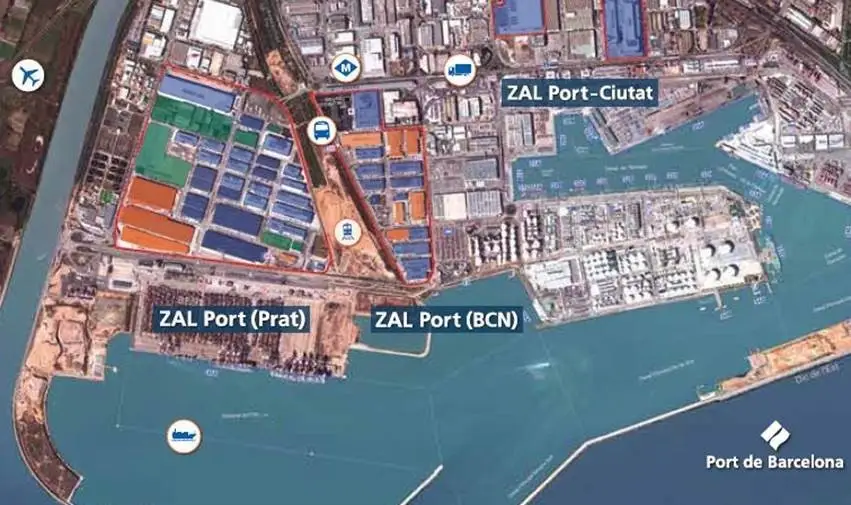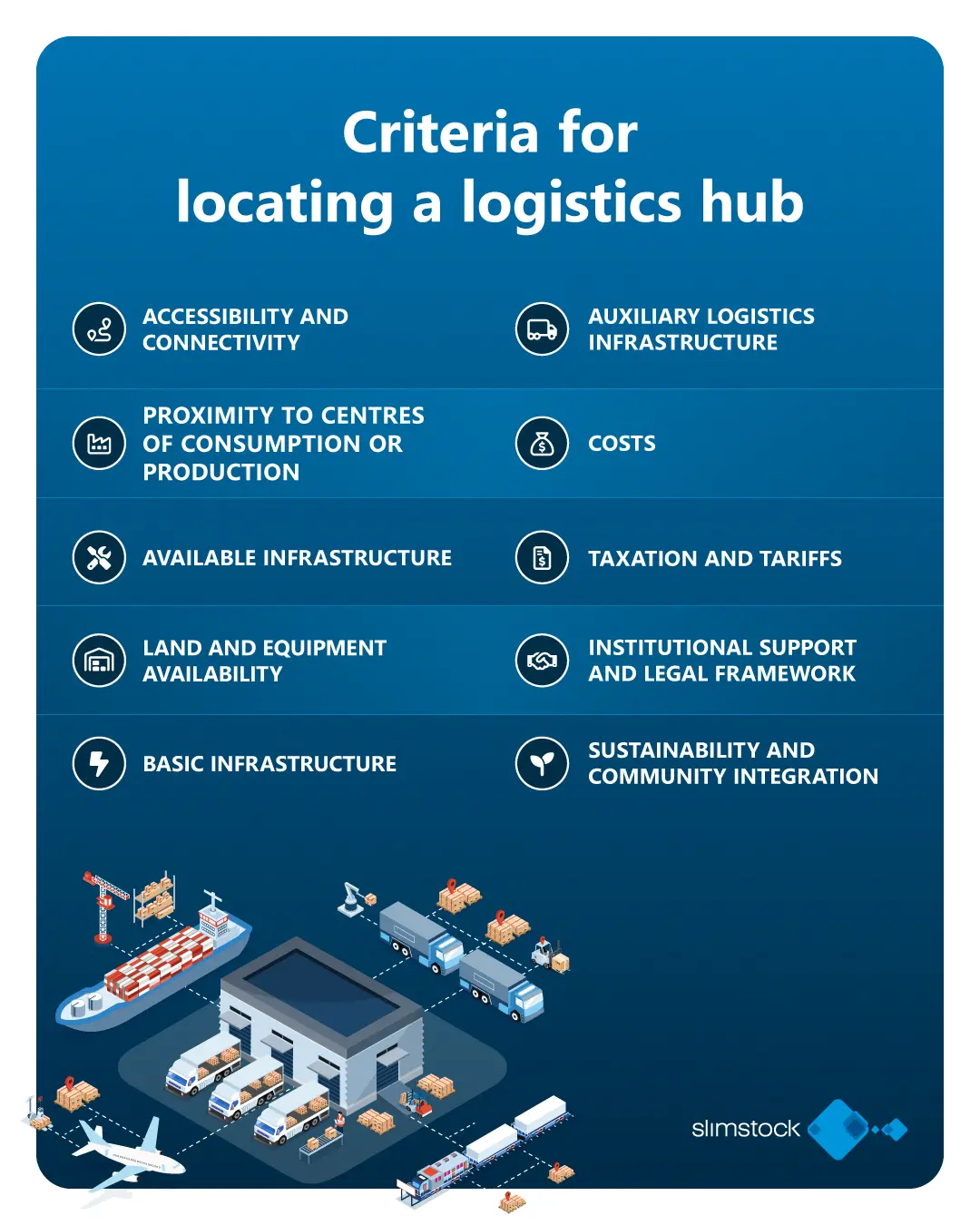Table of contents
Table of contents- Logistics hubs and their role in the supply chain
- What is a logistics hub?
- Types of logistics hubs
- Main characteristics of a logistics hub
- Benefits of a logistics hub
- Criteria for the location of a logistics hub
- Logistics hubs, a key part of global supply chains
When it comes to supply chains, everything is interconnected. We have seen this with the recent supply chain disruptions and, of course, with the US-driven tariffs. In this context, logistics hubs have established themselves as key infrastructure to ensure the smooth movement of goods on a global scale.
However, despite their growing importance, in many respects the concept is still unclear. In this article, we will try to shed some light on what they are and what their role is in the supply chain.
What is a logistics hub?
Let’s start by clarifying that a logistics hub is not a fully defined concept. In other words, there is no list of requirements that must be met for a facility to be labelled a logistics hub. However, this category does serve to indicate the functionality of the facilities that is categorised as such.
In general terms, however, a logistics hub is a central node in the supply chain where transport, warehousing and distribution activities are concentrated. It usually serves as a point of consolidation and redistribution of cargo, where goods from different origins come together to be sorted and stored and then sent to multiple final destinations.
Although, as we said, there is no fixed definition, the majority of logistics hubs share certain characteristics: large facilities with multi-client capacity, high transport connectivity (roads, rail, ports or airports) and the provision of added logistics services (storage, packaging, customs management, etc.).
In essence, the hub acts as a central point that facilitates the efficient flow of goods in the logistics network, providing value through economies of scale and scope.
Types of logistics hubs
Globally, logistics hubs come in various forms and scales, and can be broadly classified into two main groups: public or open logistics hubs, designed to serve multiple companies and sectors (such as ports, logistics zones or intermodal platforms); and private logistics hubs, developed by specific companies to centralise and optimise their own supply chains.
Open logistics hubs
Open hubs are characterised by their multimodal nature and their shared infrastructure, which makes it possible to concentrate and redistribute goods from different origins and destinations on a large scale.
In Europe, the port of Rotterdam is one of the paradigmatic cases: it serves as a gateway to the continent thanks to its high transhipment capacity, its connectivity with waterways, railways and motorways, and its associated logistics-industrial ecosystem.
In Asia, Singapore is another global benchmark. Its port – one of the busiest on the planet – and Changi airport make up a highly efficient and technologically advanced logistics complex, making it an essential hub for intercontinental trade between Asia, Europe and Oceania.
In Spain, the Port of Barcelona and its Logistics Activities Zone (ZAL) represent a clear example of an open hub. Directly connected to the port and El Prat Airport, and linked by rail and motorways, this logistics cluster serves maritime operators, carriers, 3PLs and major distribution brands. Thanks to its free zone status, it is also a key point for import/export operations with Africa and Asia.
These hubs, usually driven by port authorities or public consortia, play a key role in the efficient movement of goods through regional and international networks.
Private logistics hubs
In parallel, there are hubs developed by private companies with the objective of optimally managing their own logistics network. These centres are custom-designed for their production or commercial processes, integrating specific technologies and flows.
In Spain, the Airbus hub in Illescas (Toledo) stands out. This facility manages the logistics of large aeronautical parts for assembly plants in Europe. Equipped with advanced handling and storage systems, it is an essential node in Airbus’ industrial network, especially for the A350 and A320 programmes.
Also in the country, Inditex manages from its headquarters in Arteixo (A Coruña) a logistics complex that acts as a global distribution centre. From there, the textile group coordinates in real time the shipment of products to thousands of shops on the five continents, with a very high inventory turnover and very tight transit times.
On an international level, a significant example is the logistics hub of Zalando in Erfurt (Germany), which uses this automated centre to provide logistical support to its e-commerce model in Central Europe, or the Volkswagen Group Logistics Center (Kassel, Germany), whose logistics centre managed by the Volkswagen Group itself coordinates the supply of parts to multiple factories within the consortium in Europe.
Main characteristics of a logistics hub
In general, logistics hubs share a number of key characteristics in their design and operation:
1. Multimodality in transport
A hub is usually equipped to allow multiple modes of transport (truck, rail, ship…). This multimodal connectivity allows each mode to be used for the most appropriate stage of transport, facilitating efficient transhipments. For example, an ideal hub will connect its warehouses to major highways and railways, and even have port or airport access nearby. Intermodality reduces cost and time by enabling large volumes to arrive via rail or ship, and then be distributed by road in the final legs.
2. High-capacity infrastructure
Hubs require extensive and specialised physical facilities. This includes high volume warehouses, bulk loading/unloading docks, container yards, handling equipment (gantry cranes, forklifts, automatic sorting systems) and where appropriate cargo terminals (rail or inland port terminal).
3. Technology integration
Technology is a key enabler in modern hubs. Advanced logistics IT systems, such as WMS (warehouse management systems), TMS (transport management systems) and tracking platforms, are used to coordinate the flow of goods in real time. Likewise, high levels of automation have been incorporated in warehouses and terminals (automatic sorters, AGV robots, automatic cranes, etc.) to maximise speed and minimise errors.
In this sense, the so-called Control Towers are an essential complement to provide real-time visibility to the hub’s agents. Currently, Digital Twins are being added to this technological scenario, which also make it possible to simulate flows and anticipate disruptions and bottlenecks.
4. Connectivity to other networks
A logistics hub functions as part of a network, so its value lies in how well it is connected to other nodes. Leading hubs are often part of international trade corridors or centrally located to their target market. They have high transport frequencies to/from many destinations: e.g. daily freight train schedules, dozens of truck departures per day to various points, regular nightly cargo flights, etc.
High traffic volumes lead to more frequent departures and higher levels of consolidation, which improves speed and reduces unit costs. In terms of digital connectivity, a state-of-the-art hub also shares information with partners (customers, suppliers, customs) in an agile way, facilitating documentation processes and full traceability of shipments.
5. Scale and agglomeration of operators
Finally, a hub usually implies business concentration. Multiple logistics companies (carriers, 3PL operators, customs agencies) and loading companies (distributors, manufacturers) operate within them. This agglomeration generates external economies: as there are many transport providers, warehouses and customers close to each other, delivery routes are short (savings in ‘last mile’ within the hub), the probability of return trips with cargo (backhaul) is increased, and certain resources (equipment, infrastructure, specialised labour) can be shared between competing companies. In addition, this diversity of players tends to attract ancillary services (maintenance, security, logistics training, financial services, etc.), strengthening the ecosystem.
Benefits of a logistics hub
Having a well-developed logistics hub brings multiple advantages for the supply chain and the economy, including:
1. Reduction of logistics costs
The concentration of flows in a hub allows economies of scale and transport density to be exploited. By consolidating shipments, trucks, containers or planes are filled more efficiently, reducing the cost per unit moved. Empty miles are also reduced: delivering to a hub increases the likelihood of picking up return freight, avoiding empty return trips.
2. Supply chain efficiency and reliability
A hub increases operational efficiency by concentrating services and facilitating logistics coordination. The availability of multiple carriers and frequencies ensures greater capillarity and shipping options. For example, in a large port or air hub, shipments are more frequent, reducing waiting times to consolidate cargo. Specialised infrastructure and expert staff in the hub also improve the quality of service (fewer errors, professional handling). This results in shorter and more predictable delivery times for end customers.
3. Improved delivery times
Locating goods closer to key markets (or at well-connected nodes) speeds up distribution. Even in manufacturing, hubs enable Just in Time schemes where components arrive just-in-time to the production line. In short, centralisation followed by fast distribution from the hub reduces overall lead times.
4. Sustainability and reduced environmental impact
The logistics hub tends to be more eco-efficient than many disconnected points. By consolidating loads, the number of trips required per tonne moved is reduced, reducing fuel consumption and emissions per unit. The possibility of using cleaner modes of transport (such as rail or large vessels) on long hauls to the hub, replacing dozens of individual trucks, significantly reduces the carbon footprint. In addition, green technologies can be implemented in hubs in a concentrated way: for example, electric or bike-charging fleets for urban delivery, solar generation on warehouse roofs, or electrification of port cranes. Continuous inventory turnover in a hub also avoids accumulation of obsolete stock, which in certain sectors (e.g., food) reduces waste.
Criteria for the location of a logistics hub
The choice of the ideal location to implement a logistics hub is a complex strategic decision that involves expenditures of tens, if not hundreds, of millions of euros. So, what criteria are taken into account when it comes to locating these infrastructures?
Accessibility and multimodal connectivity
The number one priority is usually the accessibility of the site and its integration into transport networks. A hub should be located where it has easy access to the main communication routes: high-capacity motorways, rail corridors, nearby sea or river ports and/or a nearby cargo airport.
Proximity to consumption or production centres
Closely linked to the previous one, this criterion emphasises being close to sources or load sinks: either close to large industrial production centres (to easily pick up goods), or close to large consumer markets (to distribute goods quickly). Ideally, a relevant hub is ‘in between’ the production and consumption points of the global chain, capturing flows from both sides.
For example, the main European hubs (Netherlands, Belgium, the German Ruhr) are surrounded by a very high population density with high purchasing power, which guarantees logistical demand. Likewise, in national logistics, locating the hub ‘in the centre’ is frequent in order to minimise distances to the rest of the regions (e.g. central area of the Peninsula to supply the whole of Spain).
If the hub is more export-oriented, then the key proximity is to production areas: a hub near manufacturing poles. If it is oriented towards import/distribution, proximity to urban centres of consumption is fundamental (this is why many national logistics hubs are located on the outskirts of large cities).
Available infrastructure
Before setting up a hub, the existing or potential infrastructure of the location is analysed. This covers several layers: transport infrastructure (already mentioned), logistics infrastructure (land, wharehouses), and utilities.
Availability of land and equipment
A hub requires significant tracts of flat, developable land. It is assessed whether the area has large plots of land available, zoned for industrial/logistic use, with the possibility of future expansion. Also whether there are already existing warehouses or facilities that can be used.
Basic infrastructure
There must be good access to basic services: abundant electricity (to operate cooling, lighting), water, communications (fibre optics), waste management, etc. The robustness of the electricity grid is vital, for example, to avoid blackouts that can bring operations to a halt. Areas with consolidated industrial parks usually have these facilities in place.
Ancillary logistics infrastructure
Consideration is given to whether there is a nearby presence of logistics equipment suppliers, truck workshops, and existing operators. A hub in an already developed logistics pole benefits from synergies with neighbouring warehouses and operators.
Logistics and labour costs
Location cost factors are determinants of viability. They include:
Cost of land or rents
Setting up a hub involves buying or leasing large tracts of land or warehouses. Very central or saturated areas (e.g., metropolitan area of a capital city) can have prohibitive real estate costs, while locations 50 km away with similar connectivity can be much cheaper. A balance is sought between proximity to markets and cost per square metre.
Labour costs
Labour is a large component of logistics cost (warehouse operators, drivers, management staff). Locations in regions with lower wages offer a competitive advantage. For example, Eastern Europe not only has cheap land but also logistics wages that can be a third of those in countries such as the Netherlands or Germany. This has driven the establishment of pan-European distribution hubs in countries such as Slovakia or Poland. However, costs have to be balanced with availability and skills: if the cost is low, but there are not enough trained logistics staff, the efficiency of the hub may suffer.
Fiscal and customs costs
Local taxes, property taxes, possible transport taxes, etc. are analysed. Some regions offer tax incentives (tax exemptions for X number of years, VAT and duty free zones for goods in transit) to attract hubs.
General operating cost
Includes local fuel prices, tolls, electricity tariffs, etc., which vary geographically. A country with expensive fuels makes distribution from that hub more expensive compared to a neighbouring country with cheaper energy.
Logistics hubs, a key part of global supply chains
Logistics hubs act as true neuralgic nodes connecting producers with consumers on a global scale, making international trade as we know it possible. A well-located and managed hub brings efficiency, speed and resilience to supply chains: it makes it easier for goods to travel thousands of kilometres and reach factories or shops on time, reduces overall logistics costs through economies of scale, and offers flexibility to reroute flows in the event of unforeseen events (for example, by diverting shipments to an alternative hub if another hub is affected by a crisis).
Businesses frequently use cutting-edge digital tools like Slimstock’s network balancing solution to accomplish such ideal inventory distribution and network efficiency. This solution helps balance stock levels across multiple hubs and warehouses, guaranteeing that the right products are in the right place at the right time.
In addition, logistics hubs generate positive local economic impacts and their presence often drives logistics innovation (by concentrating multiple actors seeking to optimise their processes).








